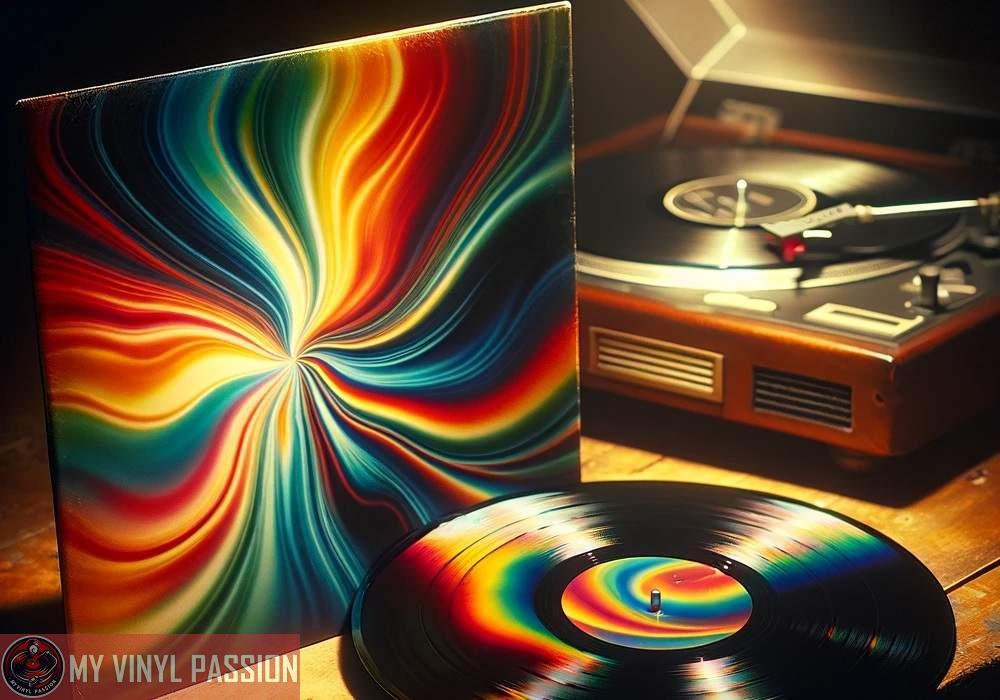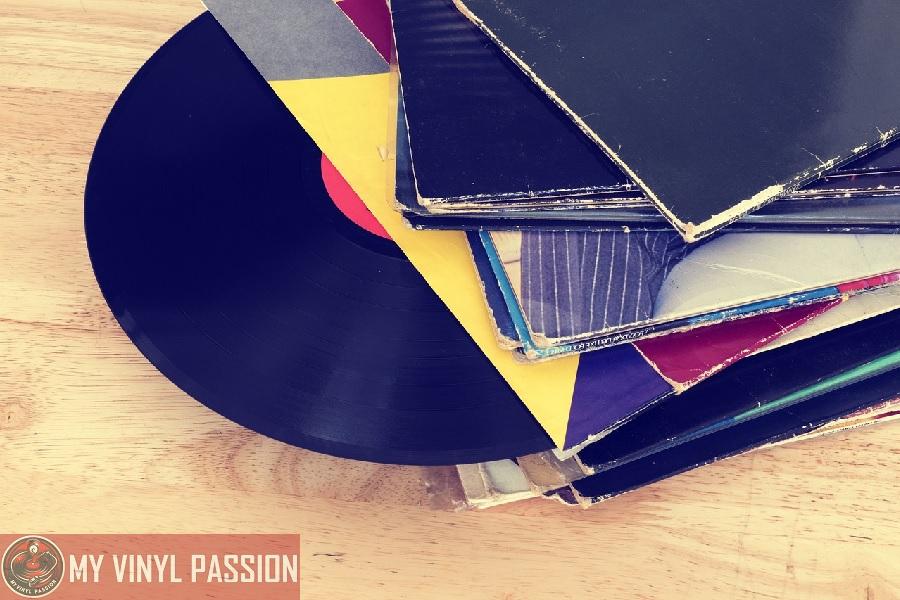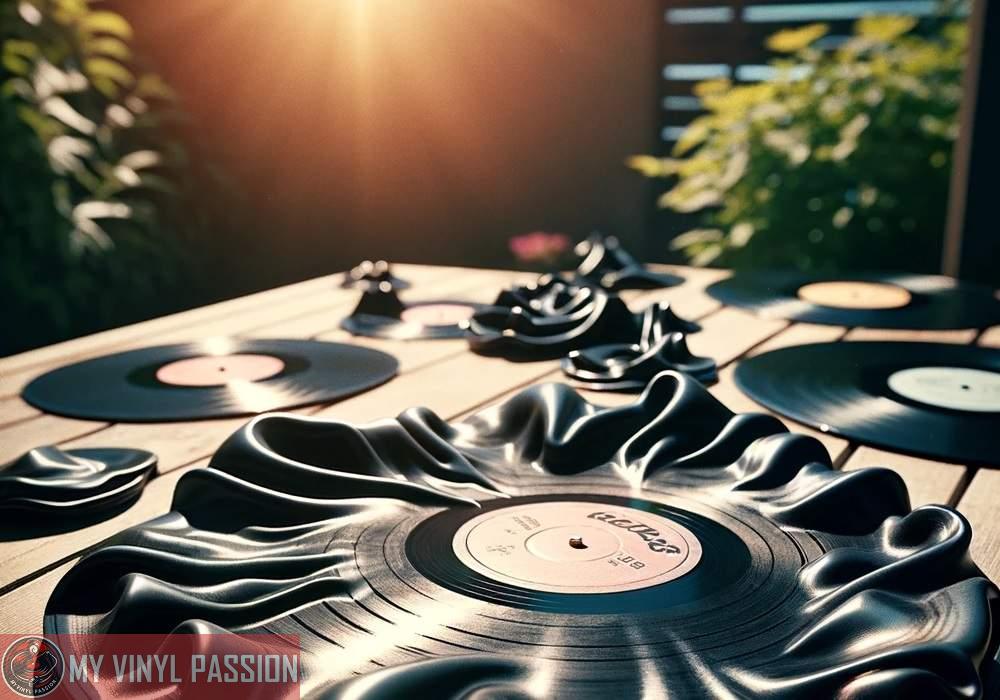In the world of vinyl records, there has always been a debate about whether colored vinyl affects sound quality when compared to its classic black counterpart.
While some collectors argue that colored vinyl may have inferior audio reproduction due to the materials used during production, others claim that advancements in technology have bridged this gap, and sound quality differences are negligible.
In Summary
Colored vinyl has been debated for its alleged inferior audio quality, although some argue advancements in technology have diminished the difference.
Examining the production processes and materials of both types of vinyl reveals the key factors that influence sound quality.
Aesthetics, collectability, and preferences play a prominent role in people’s choices between colored and black vinyl records.
The history and evolution of vinyl records have seen many changes in materials and production processes, with colored records gaining popularity due to their unique aesthetics and collectability.
However, the debate among enthusiasts and audiophiles continues, often fueled by personal experiences, preferences, and even specific case studies involving artists like White Stripes and Aphex Twin.
To have a clearer understanding of this ongoing argument, it’s essential to delve into the production processes of both black and colored vinyl, analyze their sound quality and acoustic properties, and explore various advancements in technology and materials used in pressing vinyl records.
History and Evolution in Vinyl Records
In the early days of vinyl records, mono recordings were the standard. You might remember the flat and centered sound they produced, filling your room with a single audio dimension.
But as recording technology advanced and we entered the stereo era, record companies and collectors alike embraced the new depth and realism that stereo records offered.
By the 1960s, vinyl records became the go-to choice for most music lovers, providing great sound quality at an affordable price. Throughout the years, various factors, like weight and diameter, could greatly impact a record’s durability and sound quality.
The 180- and 200-gram vinyl records that you often find today are the preferred choice for both audiophiles and collectors due to their excellent durability.
Now, let’s talk about the impact of color on vinyl sound quality. You might be wondering, do colored vinyl records sound worse? The truth is that colored vinyl records, when produced properly, yield the same sound quality as black ones.
Early colored vinyl came with its own set of issues, but advancements in production techniques have resolved those problems.
Initially, these much sought-after records were produced using dyes and pigments that could adversely affect the sound quality. The materials often contained trace amounts of contaminants which translated to noise in audio playback.
But, over time, improvements in manufacturing processes led to a much cleaner production environment. These advances eliminated unwanted noise, allowing colored vinyl to achieve the same sound quality as its black counterpart.
Today, record companies are aware of the high standards that collectors have for both audio quality and visual appeal. Thus, they put a great deal of effort into producing eye-catching colored vinyl records without compromising on sound.
You’ll frequently find colored vinyl used for limited edition releases, appealing to both the casual listener and seasoned collector.
In conclusion, there is no inherent difference in the sound quality of colored vinyl records compared to black vinyl records when manufactured with care. As a collector or music enthusiast, you can confidently purchase colored vinyl, knowing that modern manufacturing processes have made it possible to achieve excellent audio playback regardless of the color.
So go ahead and indulge in those vibrant hues, adding a splash of color to your vinyl collection without any fear of compromised sound quality.
Colored Vinyl Vs Black Vinyl
When it comes to collecting and enjoying vinyl records, a question often arises: Is there a difference in sound quality between colored vinyl and its black counterpart? In this section, we’ll briefly discuss the potential sonic differences between the two, while also touching on the topic of aesthetics.
Firstly, it’s essential to understand that both colored and black vinyl records are made from the same basic material – polyvinyl chloride (PVC). The difference in appearance is due to the addition of dyes or pigments to the PVC during the manufacturing process.
Now, let’s explore some common beliefs and concerns about colored vinyl.
- Myth: Colored vinyl sounds worse than black vinyl. This belief is not necessarily true. The sound quality of a vinyl record depends on various factors, such as the quality of the master recordings, the manufacturing process, and the condition of the record itself. While it’s possible for colored vinyl to be of lower quality than black vinyl, this is not inherently the case.
- Fact: Colored vinyl can be more susceptible to background noise. Some colored vinyl pressings might have increased surface noise (crackling, clicks, or pops) compared to their black counterparts. This is due to the additives in the dye and, sometimes, lower-quality PVC used in the production process. However, it’s important to remember that this is not an absolute rule, as advancements in manufacturing have mitigated many of these concerns in recent times.
- Aesthetics: The allure of colored vinyl. Despite the potential challenges mentioned above, many collectors and enthusiasts appreciate colored vinyl records due to their visual appeal. Unique patterns, splatters, and translucent variants can add a distinctive touch to a collection, making individual records stand out.
When examining the differences between colored and black vinyl records, the bottom line is that the sound quality ultimately depends on factors beyond the vinyl’s color.
Manufacturing techniques, the quality of source materials, and the care taken by collectors to maintain their records all play a significant role in affecting the sound outcome.
So, when choosing between color vinyl options and their black counterparts, it’s essential to prioritize your preferences – whether that be sound aesthetics or visual appeal – and always research the specific pressings for known issues or inconsistencies.
Production Processes: How They Differ
When it comes to vinyl records, you might wonder if there’s a difference in the production processes between black and colored variants. To help clarify any doubts, let’s dive into the production aspects of both types of vinyl records.
First, it’s important to understand the basic steps of vinyl record production. The process starts with PVC pellets which are the base material for vinyl records. These pellets are heated and molded into a puck or biscuit that is later pressed into the final record shape.
The manufacturing process typically occurs in a pressing plant or a production plant, where specialized machines and equipment are used.
Most vinyl records, regardless of color, follow a similar production process:
- PVC pellets are heated and mixed with additional components to create a blend.
- The blend is formed into a biscuit or puck.
- The biscuit is placed in a hydraulic press, along with the stamper, to create the record.
- Edges are trimmed, and the record is inspected for defects.
The primary difference between black and colored vinyl lies in the formulation of the initial PVC blend. In the case of black vinyl, carbon black is added to the mixture to give the record its distinctive color.
Carbon black serves a functional purpose as well—it reinforces the PVC and improves its stability under exposure to heat.
On the other hand, colored vinyl is created by using pigments along with the PVC pellets to create a variety of hues. Although the pigmentation process doesn’t inherently result in a lower-quality record, complications can arise during the pressing stage.
Specifically, there are concerns that certain pigments might compromise the consistency of the PVC blend, leading to potential imperfections during the pressing process.
It’s also worth noting that specialized pressing plants might have different practices and levels of expertise when it comes to producing colored vinyl. Some plants have more experience working with colored PVC and can maintain a higher standard of quality throughout the manufacturing process.
In summary, the production processes of black and colored vinyl records mainly differ in the composition of the PVC blend and the expertise of the pressing plant. While the differences are often negligible, it’s essential to understand these distinctions when assessing the potential sound quality of a vinyl record.
Sound Quality and Acoustic Properties
When considering the sound quality and acoustic properties of colored vinyl vs black vinyl, it’s essential to compare their manufacturing processes and materials. In the past, colored vinyl discs typically contained additives to achieve their vibrant hues.
These additives could compromise the overall audio quality and lead to increased surface noise. However, advancements in manufacturing and quality control have rendered this issue less significant today.
Manufacturing Differences: Today, most colored vinyl records are made from the same high-quality materials as black vinyl, only without the addition of carbon black pigment.
In fact, clear vinyl is often the purest form of vinyl, containing virtually no additives. As a result, you can expect similar audio quality from both colored and black vinyl records as long as they are produced by reputable pressing plants.
- Audio Quality: No major difference in modern manufacturing
- Performance: Equal, assuming good pressing quality
- Surface Noise: Slightly higher in some cases, but largely negligible with proper care
Pressing Quality: A significant factor affecting the sound quality of both colored and black vinyl is the pressing quality. Poorly pressed records, regardless of color, may have increased surface noise, non-fill, or off-center grooves. To ensure optimal audio fidelity, choose releases from reputable pressing plants known for their quality control processes.
In summary, the sound quality and acoustic properties of colored vinyl records should be on par with black vinyl records in most cases. The key factor is the pressing quality, which determines the overall performance and longevity of your records. When cared for properly, well-pressed colored vinyl can provide a listening experience just as enjoyable as its black counterpart.
Aesthetics and Collectability
When it comes to colored vinyl vs black in your collection, one aspect to consider is their aesthetic appeal. Colored vinyl often stands out with vibrant and eye-catching colors, making them a visually appealing addition to any record collection.
For instance, multi-colored and glow-in-the-dark records can add a unique element to your collection, enhancing the overall visual experience.
As a collector, you may be excited to find limited edition, colored vinyl releases of your favorite bands. These editions often feature special album art or designs that can make them worth more than standard black vinyl records. This added value is especially significant for collectors who appreciate the rarity and exclusiveness of such editions.
Here are a few factors that contribute to the collectability of colored vinyl:
- Limited editions: Colored vinyl is often produced in limited quantities, increasing its value and desirability among collectors.
- Album art: The visuals of colored vinyl can complement or enhance the album art, making it an even more appealing part of your collection.
- Unique variations: With a variety of colors and patterns available, colored vinyl can offer something for everyone’s taste and personal preference.
However, it’s important to note that not all colored vinyl is worth more than their black counterparts. In some cases, the value may be dependent on the rarity or popularity of the band and album. It’s essential to do your research and examine the specific market for a particular record before determining its worth.
In summary, colored vinyl can have a strong aesthetic appeal and add a unique aspect to your collection. Considering factors like limited editions, album art, and unique variations can help you understand the potential value and desirability of these records.
As a collector, it’s up to you to decide whether colored vinyl is worth the investment based on your personal preference and collection goals.
Advancements in Technology and Material
In the past, colored vinyl was known to have inferior sound quality compared to black vinyl. However, with modern technology and improvements in material quality, colored vinyl records have a significantly better listening experience.
Nowadays, modern colored vinyl records use advanced technology and manufacturing processes that ensure high-quality sound. The main factors determining the quality of a vinyl record are the ingredients used in its production, vinyl strength, and molding precision.
Both colored and black vinyl records are made of the same base material: polyvinyl chloride (PVC). The difference comes from the added colorant. In older colored vinyl records, colored pigments would sometimes cause a reduction in sound quality.
Today’s colored vinyl uses materials and dyes that do not interfere with the grooves of the record or the playback experience.
Advancements in technology and materials have contributed to the following improvements:
- Vinyl Strength: Modern colored vinyl records have improved durability and resistance to warping. This ensures that your records will maintain their sound quality even after multiple plays.
- Molding: Precision molding techniques have reduced surface noise in both colored and black vinyl records. This means a clearer, crisper sound for the listener.
- Colorant: Today’s colored dyes are made with higher quality ingredients that do not impact the grooves or the sound quality of the record.
In conclusion, the advancements in technology and materials have leveled the playing field between colored and black vinyl records in terms of sound quality. As long as the record is well-manufactured and properly cared for, you can expect an enjoyable listening experience from both types of vinyl.
Debate Among Enthusiasts and Audiophiles
The debate between colored vinyl and black vinyl has been an ongoing topic among enthusiasts and audiophiles for years.
Some argue that colored vinyl can sound worse due to the materials used in the manufacturing process, while others claim that the materials and processes have advanced to the point that there is no difference in the sound quality. In this section, we explore these arguments and the reasons behind them to provide you with a well-informed understanding.
Material Differences and Manufacturing Process
- Black Vinyl: Most black vinyl records are made using a mix of polyvinyl chloride (PVC) and a black carbon additive, which strengthens the vinyl and reduces static. Audiophiles often argue this allows for better sound quality due to less noise and better durability.
- Colored Vinyl: Historically, colored vinyl records were made with inferior materials, such as low-grade PVC or even non-PVC plastics, which could have resulted in a less-than-perfect sound quality. As modern manufacturing processes have improved, the materials used for colored vinyl have also evolved. High-quality colored vinyl now matches black vinyl in terms of sound quality and durability.
It’s important to keep in mind that the manufacturing process plays a significant role in the resulting sound quality of both colored and black vinyl records. For instance, improper pressing or using low-quality stampers can cause surface noise and other issues regardless of the vinyl color.
Care and Maintenance
Another consideration for audiophiles and enthusiasts is the care and maintenance of records. Some might argue that black vinyl offers an advantage since it’s easier to spot dust and dirt on the surface.
Yet, colored vinyl should not be overlooked, as an attentive listener can maintain cleanliness on their colored records by simply using a proper cleaning routine.
When it comes to the debate among enthusiasts and audiophiles over the sound quality between colored and black vinyl, there’s no one-size-fits-all answer. Factors like the manufacturing process and proper care can have a significant impact on the sound quality of both.
Ultimately, it’s up to you to decide which option suits your personal preferences and collecting goals. Just remember that a well-cared-for record, regardless of color, will provide the best listening experience possible.
Case Studies: White Stripes and Aphex Twin
The White Stripes released their self-titled debut album in 1999, which was initially available on black vinyl. However, subsequent reissues of the album featured limited edition, colored vinyl variants, including red and white.
Many collectors and audiophiles bought these colored versions, but did the potential difference in sound quality between colored and black vinyl matter to them?
To begin, it’s essential to understand that colored vinyl records are made from the same material as black vinyl records – polyvinyl chloride (PVC). The only difference lies in the pigments added to the PVC.
In the case of the White Stripes’ album, the colored pigments did not alter the quality of sound that listeners experienced. In fact, most people found it hard to distinguish any difference in sound quality between the black and colored variants, suggesting that the colored editions maintained the same level of audio fidelity.
Another fascinating case study revolves around Aphex Twin and his critically acclaimed album, Selected Ambient Works Volume II. This album has been pressed on both black and colored vinyl, with the latter being a limited edition, brown vinyl.
Some listeners have reported slight surface noise differences between the black and brown pressings, which might have resulted from:
- The quality of vinyl pellets used (black or colored)
- The pressing plant’s competence and quality control measures
- The condition and maintenance of the pressing equipment
However, these differences were subtle and didn’t detract from the listening experience for most fans of the album. It’s important to note that such differences could occur in any vinyl pressing process, regardless of the color.
In conclusion, the case studies of the White Stripes and Aphex Twin indicate that colored vinyl usually doesn’t have a significant impact on sound quality compared to black vinyl.
Remember, though, that factors like pressing quality, pellet materials, and equipment maintenance can also affect the audio fidelity of any vinyl record. When adding to your vinyl collection or listening to your favorite tunes, you can confidently choose colored vinyl without worrying about any drastic difference in sound quality.
Frequently Asked Questions
Does the color of vinyl affect sound quality?
No, the color of a vinyl record doesn’t inherently affect its sound quality. Sound quality is mainly determined by the quality of the materials used, the pressing process, the mastering, and the condition of the vinyl. Colored and black vinyl are often made from the same PVC material, and the color is achieved by adding a dye during the manufacturing process. If the record is well-made, its color should not have an impact on the sound quality.
Are colored vinyl records more valuable?
The value of a colored vinyl record largely depends on its rarity, condition, and desirability among collectors. Limited edition pressings in unique colors or patterns can fetch higher prices, simply because they are harder to come by. However, a common colored vinyl record may not hold any additional value over its black counterpart.
What is the history of colored vinyl?
Colored vinyl records have been around since the early 20th century, with some of the first known examples being children’s records produced in the 1920s. Vinyl records in colors other than black became more popular in the 1960s and 1970s, often used as promotional items, limited editions, or for aesthetic reasons. Over the years, collectors have been attracted to colored vinyl for its unique appearance and novelty factor.
How does the sound quality of picture discs compare?
Picture discs are a type of colored vinyl record that feature an image or design on their playing surface. Due to their manufacturing process, picture discs can sometimes have slightly lower sound quality compared to regular vinyl records. The grooves on picture discs may not be as deep or well-defined, which can cause occasional distortion or diminished audio quality. However, many people still enjoy the visual appeal of picture discs and collect them for their artistic value.
Why might some vinyl records have poor sound quality?
There are various factors that can contribute to poor sound quality in vinyl records. These could include improper handling and storage, poor pressing techniques, low-quality materials or mastering, and damage to the record itself. In some cases, colored vinyl may have lower sound quality due to impurities in the dye used, but this is not a given and can vary between manufacturers and specific batches of vinyl.
What is the most common alternative color for vinyl records?
There isn’t a specific alternative color that is the most common, as colored vinyl can come in a wide range of shades and patterns. However, some popular options include translucent colors such as clear, red, or blue, as well as solid colors like white, gold, or silver. Some vinyl records even feature a mix of colors or special patterns like a swirl or splatter design.





